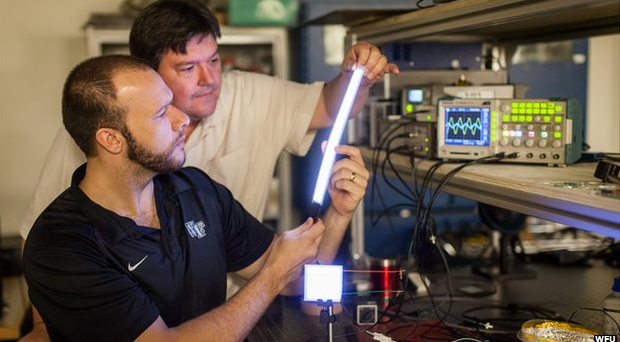Goodbye LEDs, hello plastic bulbs?


--
Just when LED light bulbs seemed to be gaining traction, along comes a technology that researchers insinuate could trump them: Plastic.
Meet the Fipel - the field-induced polymer electroluminescent light source. According to physicists at Wake Forest University in North Carolina and Trinity College, Dublin, a Fipel requires less energy than a fluorescent bulb does, the BBC reports.
Thus, a Fipel would also be more energy efficient than an LED bulb, since LEDs and fluorescents require about the same amount of electricity. As I wrote last week, LED vendors are struggling in the vast market for commercial office lighting, where buyers are not willing to pay the higher price that manufacturers charge for LEDs, even though LEDs last longer and have other advantages.
The BBC story does not mention any prices for Fipels. But if Fipels represent a significant energy saving over fluorescents, that might induce buyers to spring for them.
Inventor David Carroll, a professor at Wake Forest, says a corporate partner will start producing them next year. Fipels use "three layers of white-emitting polymer that contain a small volume of nanomaterials that glow when electric current is passed through them," according to the BBC.
The Wake Forest team originally wrote about its developments in the journal Organic Lighting.
WARMING
The BBC explains that Fipel light is warmer than fluorescents. The story does not compare the light quality to LEDs' quality, which many people regard as superior to fluorescent and inferior to the warm but inefficient incandescent bulbs still common in homes.
Carroll notes that whereas "curly cue" fluorescent bulbs emit a harsh bluish light that can cause headaches, the light from his bulb accommodates the human eye because it "can match the solar spectrum perfectly."
That sounds potentially better than LED light quality.
Carroll claims at least four other advantages for Fipels over fluorescents:
- they're brighter
- it's easy to adjust their tint
- they do not contain environmentally hazardous mercury
- they are malleable into different shapes
Their bendiness would threaten another emerging light technology: OLEDs, or organic light emitting diodes, which are natural materials that emit light in response to an electric current. They are supposed to transform lighting by allowing designers to build them into things like building fabric, support structures, furniture and fashion. Electronics makers also want to use them to create foldable phones, gadgets and TVs.
A DECADE AND COUNTING
But OLEDs "don't last very long and they're not very bright," Carroll claims. "There's a limit to how much brightness you can get out of them. If you run too much current through them they melt."
What about longevity compared to LEDs? Light emitting diodes are supposed to last for 25 years or longer (although LED bulb makers provide warranties of only about 7 years). There seems to be no hard figure for the life expectancy of a Fipel, but Carroll says he's had one working in his lab for about 10 years.
Of course, as LED bulb makers know, it's a long way from lab triumphs to market success. It's too early to tell whether people will flip for Fipels. At the least, Prof Carroll is putting pressure on LED companies to continue to improve and lower prices. That should help light the way to a more energy efficient future, regardless of which technology wins.
Photo: Wake Forest University via the BBC.
Watch for my second installment soon on the myth of LED energy savings.
More LEDS and OLEDS on SmartPlanet:
- The myth of LED energy savings
- More LED truths and half-truths
- When good lights go bad: LED breakdown
- The hot and cold of LED lighting
- Dutch push for flexible gadget screens
- Car’s ‘glass’ roof by day becomes interior light at night. Oh OLEDs!
- Roll up the iPad: Siemens advances the flexible screen
- Video: Watch this Samsung flexible tablet PC unfold
- Eye candy: Glow-in-the-dark surfing
- Samsung eyes flexible gadget screens by early 2012
- Nokia toys with flexible smartphones you can bend and twist [video]
This post was originally published on Smartplanet.com